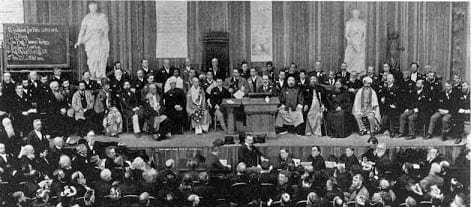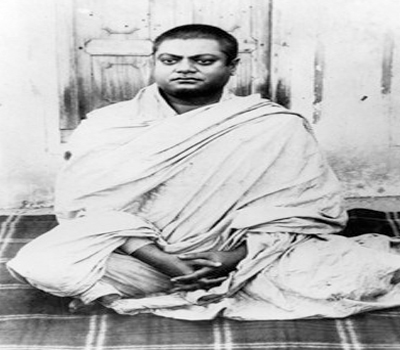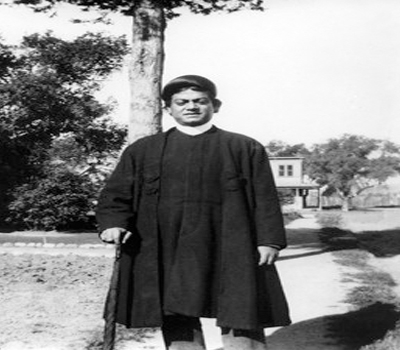Swami Vivekananda explains the idea of oneness very directly in ‘One Existence Appearing as Many’. Vivekananda tells us that the Reality ‘when seen through the senses is called the world. … When It is seen through the mind, It is called the world of thoughts and ideas; and when It is seen as it is, then It is the One Infinite Being’ (3.20). This one existence, as he calls it, is the only real entity because the distinctions we perceive between phenomena and between bodies—in time and space—are false distinctions based in maya. As persons increase their understanding of the reality, they approach an ultimate truth: ‘I am that One Existence. This is the last conclusion’ (3.21). Because notions of self and reality are so abstract, it can be difficult, at first glance, to understand what such a conclusion would mean. It is further perplexing that this ‘last conclusion’ implies that practically all of the things we engage with in our daily lives are ultimately unreal, or fall under maya. However, Vivekananda’s position is well-considered enough to answer these and other pressing issues that arise when articulating the idea of oneness.
Let us go deeper into Vivekananda’s ‘last conclusion’ and examine what it means to identify oneself with the entirety of existence. Vivekananda’s use of the first-person pronoun ‘I’ seems unusual compared to the way we normally hear the article used in conversation. It seems fundamental to ‘I’ that it refers to the person speaking, and that a person speaking is, by definition, not also the words they are saying, the others they are speaking to, the room they are speaking in, and so on. This sort of response reflects a very basic intuition that one’s identity is a discrete fixture in reality, relating in various ways to things existing external to it; we generally take our identity to be limited. Vivekananda’s project explicitly rejects this intuition: ‘All these ideas that I am imperfect, I am a man, or a woman, or a sinner, or I am the mind, I have thought, I will think—all are hallucinations; you never think, you never had a body; you never were imperfect’ (3.9). Vivekananda denies that the proper referent of ‘I’ is a person at all, explaining that our belief in our personal selves is generated by an illusion. He illustrates that the principle of non-duality should drive us to the belief in the true Self, which is all of reality, properly conceived of as a single, indivisible entity. Hence the thesis: ‘There is but One Existence’ (3.12).
The first concept Vivekananda presents that needs to be addressed is maya; what is the nature of this maya under which there falsely appear to be many distinct entities while in reality each bears a uniform special property that causes us to say it is ‘I’? Normally, when we talk about an illusion we implicitly assume the presence of some being that perceives the illusion and is thereby deluded. Call this being the ‘subject’. The conflict arises when we see that the illusion Vivekananda describes is the very existence of that ‘subject’. Who is under the influence of this illusion if not I , a person, a subject? 2 If I am truly the all-pervading entity that constitutes reality, then surely I cannot be under the illusion of maya. The notion of a subject, and therefore of duality, seems as inherent to the concept of an illusion as it is to our daily life, and so a tension arises upon investigation of maya, and the role it is supposed to play in reality.
This apparent contradiction is resolved by reframing our idea of the personal self as dispersed and incomplete, rather than as the atomic locus of perception we naturally take it to be. Within the world there are instances of perception that involve a sense of self, and some of these instances stand in a certain physical-mental-temporal relationship to one another that seems quite important from within the perspective that arises in these instances. Consequently, there forms the sense that these similarities constitute an identity, and we give that identity a name; the subject—in my case, Ben Baker.3 However, according to Vivekananda the subject—like all other real phenomena other than ‘that One Existence’—cannot be coherently described as a single entity, distinct from the rest of reality. The phenomenon is more properly understood as subjectivity, rather than as made up of subjects. It may come in various kinds and degrees, and there may be cases for which neither ‘subject’ nor ‘not-subject’ will be an appropriate designation.4 The pithy analog y often used to communicate this idea is that of a wave. While we instinctively distinguish between one wave and another, we admit under scrutiny that our distinction is arbitrary. There is nothing implicit in the water’s behaviour that forms the basis of the identities we attribute to individual waves. Vivekananda tells us that subjectivity is like this; the subject and the ‘person’ are, like waves, arbitrary and unreal identities that only appear to be distinct. Our personal identity simply is the amorphous occurrence of subjectivity, which entails an illusory sense of being discrete and separate.
When we understand this model of the person as diffused and ultimately unreal, we may become puzzled again upon considering what the view implies for causation. Rigorously and coherently describing the workings of cause and effect is a notoriously difficult philosophical endeavour, but that will be no excuse for the theory of Oneness if it cannot provide a satisfactory story of causation. Fortunately, Vivekananda provides such a story. He brings out the idea that there are different levels on which we can investigate these metaphysical concepts. We could, for example, discuss causation in human terms, which presupposes duality because of the nature of the human perspective. As long as we recognize we are adopting the stance of subjectivity, maya, which posits discrete entities that might interact, it makes sense to speak of causes and effects.5 However, if we take the discussion beyond this perspective to the level of ultimate Truth, causation falls entirely out of the picture. Vivekananda says, referring to questions whose content is importantly related to causation, ‘This question can only be asked within the limits of causation. As far as time and space and causation extend, so far can this question beasked. But beyond that it will be nonsense to ask it, because the question is illogical.’ 6
He also says: ‘Cause is never different from effect, the effect is but the cause reproduced in another form’ (3.7). He says these things because, at this ultimate level, cause and effect dissolve into one—when we take reality to be one continuous entity it is no longer coherent to say ‘A’ causes ‘B’. We are left only with ‘A’ causes ‘A’, which does not look like a statement involving causation at all, but rather a convoluted way of saying ‘A is’. This should not surprise us, since Vivekananda’s ‘final conclusion’ is really just the statement ‘A is,’ where ‘A’ stands for nature, Reality, God, or whatever name one chooses for the entity constituted by all that exists. Vivekananda shows us that if we step back from the lens of subjectivity that is appropriate in the context of human behaviour, we will see that the worrisome questions about causation never even arise.
Vivekananda’s insight to partition the discussion into the human level and the ultimate one will again be instrumental when our questions turn from causation to free will. Human freedom of the will is another favourite battleground of analytical philosophers, and Vivekananda certainly does not skirt the issue. He explains, as with causation, that the will is only a coherent notion within maya, the illusion we are distinct and separate beings. ‘It is only when the infinite existence comes, as it were, into this network of Maya that it takes the form of will. Will is a portion of that being, caught in the network of Maya, and therefore “free-will” is a misnomer. It means nothing. … There is no freedom in Maya’ (3.14). Only from within the subjective, dualistic perspective, can we understand the question of free will, since non-duality denies that the persons or their wills exist, in the sense they would need to in order to be either ‘free’ or ‘un-free’.7 If we truly want to talk of freedom we could equate it with the realization that one is not something as ‘small and insignificant and individual’ as a person.8 Vivekananda shows us why the question of free will is a human one, a limited one, and ultimately, an unreal one.
Where we have found no such thing as causation or a free will, as one would expect, we also will find no support for the normal way of thinking about good and evil. Vivekananda makes it very clear that this One reality is neither good nor evil, but perfect. He says that good and evil depend on the development of our minds, and do not exist objectively. ‘As soon as he is free, he does not see good and evil. Who sees evil and good? He who has it in himself. Who sees the body? He who thinks he is the body. The moment you get rid of the idea that you are the body, you do not see the world at all; it vanishes for ever.’9 In the course of elucidating the life and mind of the jnana yogi, Vivekananda presents this basic philosophical position: multiplicity is illusion, reality is One; and so inherently relational concepts like morality and causation disappear under the lens that has not been cracked by subjectivity. These are the theoretical foundations of Oneness. They can be found everywhere in Vivekananda’s works, but it is up to us to possess the acumen and the resolve to probe the depths of his writings and reach these abstract pieces of wisdom. If we are successful—if we can come to really understand reality as described by Advaita Vedanta—we can stand firmly on the same foundations as did Swami Vivekananda as we make our own way towards the eventual realization: ‘I am that One Existence’.
(Source: Prabuddha Bharatha Special Edition January 2014)
Notes and References
1. The Complete Works of Swami Vivekananda, 9 vols (Calcutta: Advaita Ashrama, 1–8, 1989; 9, 1997), 2.82.
2. Readers familiar with the philosophy of René Descartes will notice a close resonance here with the famous reasoning for which he is accredited : ‘I think, therefore, I am.’
3. This reasoning is reminiscent of David Hume in A Treatise of Human Nature and his ‘ bundle of psychological states’ that he resignedly identifies as the sole grounds for what we normally take the ‘self ’ to be.
4. See, for example, case studies on patients who have a severed corpus callosum as a result of experimental neurosurgery, cited in the third part of Derek Parfit, Reasons and Persons . Such patients lack the use of a main channel of communication between the two hemispheres of the brain and consequently show signs of possessing two simultaneous centres of agency, or two ‘minds’. A short video describing such a case is available at <http://www.youtube.com/watch?v=lfGwsAdS9Dc> accessed 1 No-vember 2013.
5. It is worthy to note that, because cause and effect are based on illusion, there is no need for our definitions of them to be consistent under serious philosophical questioning ; we admit, instead, that while we use these concepts in our lives, ultimately, they do not make sense.
6. Complete Works, 3.13.
7. It is a similar non-question to ask whether unicorns are free.
8. The quoted phrase is from Thomas Nagel’s essay, ‘The Absurd’, wherein he addresses the ‘conspicuous discrepancy’ between the seriousness with which we take our lives and our understanding that, outside of our own
perspective, these lives seem arbitrary. His discussion is particularly relevant to Swami Vivekananda’s position on
causation and freedom because of the clash between one’s subjective understanding of these notions and the recognition that they are constructs of the human perspective, and do not figure into the non-dual picture of reality. See Life, Death, & Meaning: Key Philosophical Readings on the Big Questions, ed. David Benatar (Maryland :
Rowan & Littlefield, 2010), 31.
9. Complete Works, 3. 28. There is some interesting overlap between this idea as Swami Vivekananda presents it and a thematic contention of Friedrich Nietzsche in Beyond Good and Evil that prevailing ideas about free will and morality are contextualized, human inventions, ultimately referring only to themselves for justification.






Leave A Comment